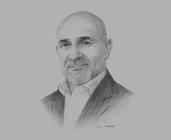Peter Grimes, President and CEO, FWD Philippines: Interview

Interview: Peter Grimes
What has been the industry’s reaction to the new framework for the valuation of insurance policy reserves and risk-based capital?
PETER GRIMES: I think it fair to say that the insurance industry’s reaction locally to the regulatory changes has been mixed. Globally, the industry has witnessed and welcomed moves towards risk-based capital and robust levels of reserving, which is essential for an insurer to be adequately solvent and resilient to volatilities in capital markets and other economic uncertainties.
Historically, insurance sales in the Philippines have largely comprised of variable unit-linked products, and therefore the local insurance industry has been less susceptible to the global low interest rate environment of recent years, which has been an ongoing challenge for many insurance companies in other parts of the world.
As far back as 2006 the Department of Finance, through the Insurance Commission, recognised the need to strengthen the capital position of Philippine insurers, and subsequently implemented revisions to the framework in 2013 to increase capital in tiered tranches every three years up to 2022. The rationale cited was that this would pave the way for a stronger insurance sector that would ensure better consumer protection and further strengthen the integrity of the industry. My understanding is that the move has not been universally popular; while most multinationals and larger domestic companies are largely supportive of the higher capitalisation requirements some other companies are less enthusiastic.
Which channels are best suited to penetrating the insurance market in the Philippines?
GRIMES: The Philippines is fast becoming a genuine multi-channel market, and this is very much the focus and future direction of a customer-led sales model. Bancassurance is an increasingly influential channel, and its growth has substantially contributed to improved levels of penetration for insurance products, as it taps into a pre-existing consumer base, where clients have already established a trusting relationship with their bank.
For some time the Philippines has underperformed compared to its regional and global peers in terms of insurance market scale, growth and penetration. Agent numbers were historically small for a population the size of the Philippines, with the country’s total life insurance agency force estimated at 30,000 only 10 years ago. If you compare this with a market like Thailand, which has a much smaller population, this amounted to only half the size of the agency force of the leading Thailand life insurer. It is encouraging that in recent years there has been a significant growth of local agents, and there remains a huge opportunity to further grow agency numbers – both in the urban and rural areas – especially as the Philippine-wide protection gap is huge and increasing across all income levels.
Agencies continue to be a vital part of the overall distribution landscape, with the industry needing both a strong bank channel and vibrant agency force because, at the end of day, we must give consumers the freedom to choose the channel and the provider they feel will best meet their savings and protection needs.
With continued technology enhancements changing consumer behaviour, particularly relating to widening internet use and mobile applications, we will almost certainly see far more meaningful contributions from non-traditional channels – especially online and digital channels – once infrastructure issues are resolved, as they are ideal for selling more straightforward or commoditised products. As our industry grows, there will also be a greater need for the right people with the right education and experience, who can be moulded into high-quality financial advisors. Advisor numbers continue to increase across all channels, and given the current economic growth in the country and continuing expansion of the local middle class, there will be a higher demand for professional insurance advisors to sell a wider variety of needs-based products.
You have reached the limit of premium articles you can view for free.
Choose from the options below to purchase print or digital editions of our Reports. You can also purchase a website subscription giving you unlimited access to all of our Reports online for 12 months.
If you have already purchased this Report or have a website subscription, please login to continue.

